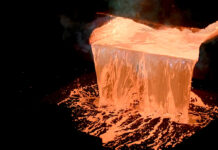[miningmx.com] — FOR ANGLO AMERICAN to pass its dividend is the South African equivalent of Lehman Bros going bankrupt.
It also casts huge doubt on the group’s recent strategy, right back to the decision to move its HQ to London. And while that strategy predates current CEO Cynthia Carroll she has at the very least been complicit in the continued implementation of the policies it entails.
Anglo knew when it moved it was converting itself over the short run from a big fish in a small pond to a small fish in a big pond. Problem is, it’s progressively become a smaller fish in that big pond. The contrast with Gencor, which was much smaller than Anglo but is now part of the world’s biggest resource company, BHP Billiton, couldn’t be greater.
With the latest fall in its share price, Anglo’s no longer even the biggest South Africa-linked public company. It’s ceded that ranking to SAB-Miller and will find it difficult to regain it.
In retrospect, even the redefinition of its core business looks catastrophic. As I’ve pointed out before, any company’s core business is whatever it decides it is – so there was no compelling logic in the exclusion of gold.
Indeed, Anglo was founded by Sir Ernest Oppenheimer specifically to fund the development of the Far East Rand goldfield and later played key roles in developing the West Wits and Free State fields. Far from being peripheral, gold was Anglo’s fons et origo.
But as a consequence, Anglo sold out of AngloGold Ashanti, whose share price is 16% up over the past year and, in effect, reinvested in Anglo Platinum (66% down) and itself (69% down). Though a longer-term comparison isn’t so flattering to AngloGold, Anglo itself is roughly a quarter lower than it was five years ago after the biggest commodity boom ever.
And few analysts would doubt it’s been apparent for most of the past year that gold had a better outlook than platinum. That makes the switch in interests even less forgivable. Why, even when Anglo released its results it announced a further cutback in its stake in AngloGold. No wonder executives at that company increasingly stress the Ashanti half of its moniker.
At least Anglo has suspended its disastrous share buyback programme. I’ve often expressed my dislike of that mechanism as “a way of returning money to shareholders” – which it patently isn’t. In the case of Anglo, it was money thrown against the wall and did nothing to retard the collapse of its share price.
Anglo’s experience simply confirms that: if companies have excess cash they should simply return it to their owners – the shareholders – who can make their own decisions as what to do with it.
I’m indebted to stockbroker David Shapiro for totting up the figures. Over the past four years Shapiro reckons Anglo spent US$10,5bn on repurchasing 212m shares. They’re now worth around $3bn. That’s a cool $7bn wiped off its asset base, plus whatever it’s lost on Anglo Platinum/AngloGold transactions.
More to the point, Anglo could have used the sum to eliminate its debt. But, of course, during the commodity boom the mantra was that resources companies should gear up their balance sheets: a fashion BHP Billiton largely resisted but the likes of Rio Tinto and Anglo didn’t – to their current cost.
From another aspect, Anglo’s 2007 final dividend of 86c/share (US) cost just more than $1bn. It spent 10 times that on ill-advised share buybacks and now can’t even afford a token dividend. Talk about destroying shareholder value.
Apologists who praise Anglo for taking the brave decision to pass its dividend should look a little more closely at just why the step became necessary. To attribute it to the slump in commodity prices – over which Anglo admittedly had no control – is just too glib.
Though the normally mild-mannered Patrice Motsepe was too polite to make the point explicit, it was impossible not to see his remark at the African Rainbow Minerals presentation a few days later that if ARM wants to be regarded as a global player it’s important for it to pay dividends as a veiled comment on Anglo’s misadventures.
ARM also shows the commodity down-cycle can be overcome. True, Motsepe wouldn’t be drawn on the current year, or even the current quarter, outlook. Frankly, those can’t be great. And while Motsepe seemed pleased that costs at most of ARM’s operations are in the best 40%, most world-class miners would want to aim higher than that.
Still, it should leave ARM in the black and, thanks to its conservative financial policies, Motsepe made no bones about ARM being in the market for suitable acquisitions.
The contrast with the other post-1994 attempt to recreate a simulacrum of a traditional SA mining house is instructive. Mvelaphanda Resources is quoted at so great a discount to its net asset value it can’t issue shares for acquisitions, or even for cash in a rights issue, without excessive dilution of its equity. It all goes to show there’s no automatic road to success: ultimately, judgment, management quality – and no doubt a little bit of luck – can make all the difference.











